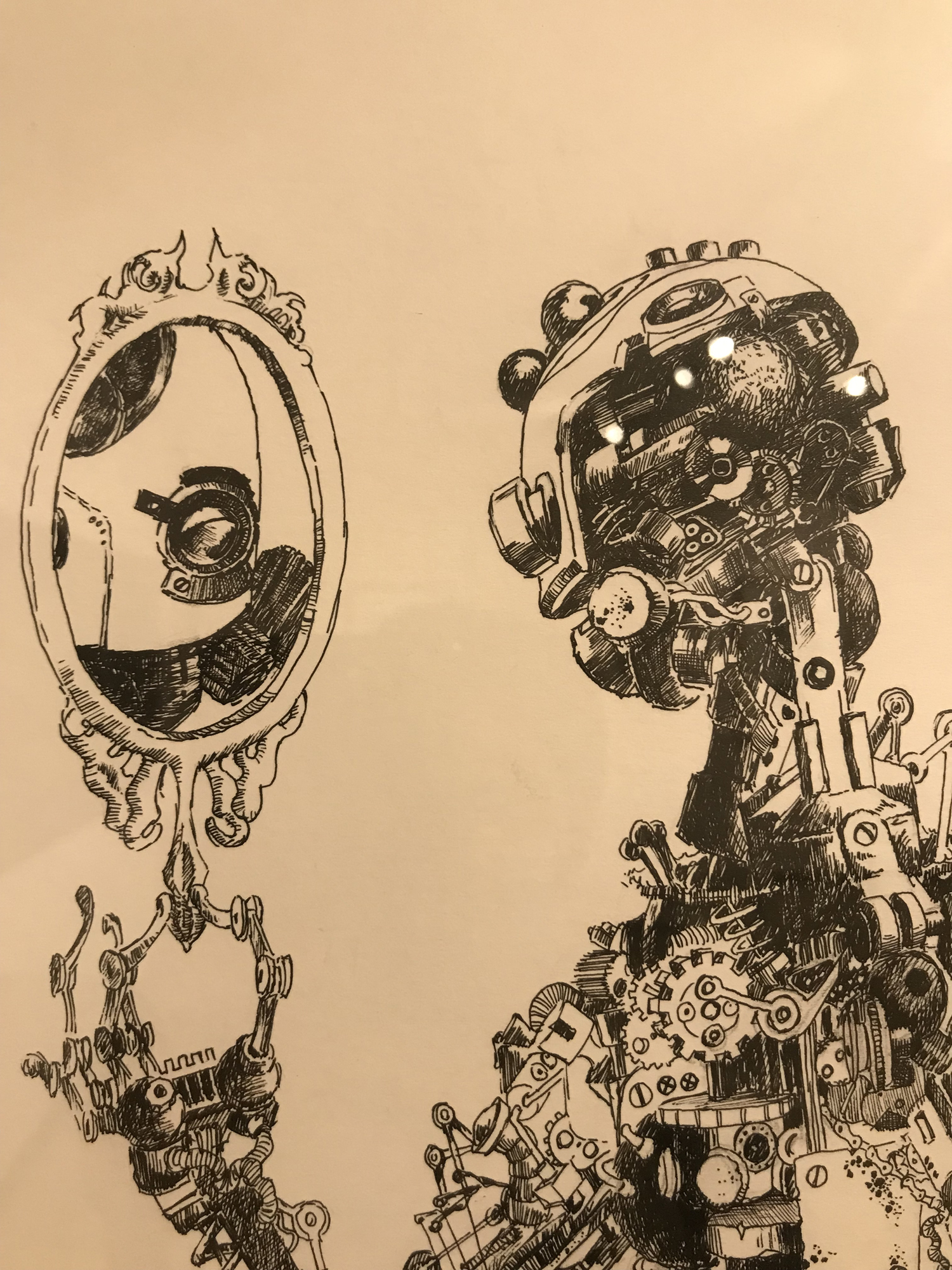The imaginarium of Samridh Mukhiya

Sitting cross-legged in the dappled light under a tree outside the Siddhartha Art Gallery, his hand resting on a knee and wearing a black baseball cap, Samridh Mukhiya says, “I am a conceptual artist.”
Inside the gallery the walls are lined with canvases in which Mukhiya has sketched pieces plucked delicately from his consciousness. Black ink on white fields give the impression of freshness, the spaces between the lines are mysterious and inviting with leitmotifs: bubbles, wells, trees, machines spewing smoke in the air, geometric shapes, strings.
Born to artist Tek Bir Mukhiya who is renowned for his cover designs for many books by Sajha Publications – such as Parijat’s Shiris ko Phool and Devkota’s Muna Madan – Mukhiya, 35, admits, “I tend to use metaphors a lot.”
Indeed, the artworks in the exhibition range from representations of quantum physics to political allegory, from mental health to the zodiac. And the result is as diverse as it is concise, without a hint of self-indulgence – even in the surreal Things I am grateful for, which was completed in 2018 as part of the series Mantra.
A giant oval face with closed eyes is supported on both sides by two hands. The face is sliced like a clean loaf of bread, but the face is unflinching and content. More hands, bonier, hold it up from below: one clutching withered flowers while another appears to be pulling at a loose fabric of skin.
But the drawing is not violent, representing instead people who have had presence in Mukhiya’s life.
“I wanted to show how, even with their own problems, people hold on to us and support us,” explains Mukhiya.

Elsewhere, a humanoid machine, complete with a dizzying assortment of cogs and wheels and four legs, looks at itself in a mirror, while its other hand carries a sleeping child.
Mukhiya explains that this is simple thought exploration of collective consciousness: “I wonder if in future humanity, instead of evolving, transfers its consciousness onto machines.”
The new pilgrim (2012) is more than a sci-fi study: it is also a commentary on present society where humans are encouraged to emulate machines and be mechanical and efficient.
Apparatus (2019), a charcoal on paper explores the deficiencies of systemic rote in education. In what looks like an old, black-and-white class photograph, students and teachers sit in rows, dressed in blazers. A spool of thread twists around them, like prison bars.
But here’s a twist: the students have nails and screws instead of heads. The heads of the teachers are hammers. This is a haunting piece that speaks for itself.
At once spiritual and scientifically curious, Sapana (2015) is reminiscent of the films by Terry Gilliam where the lines between fantasy and reality are blurred to the extent that one seamlessly blends into another. A sleeping figure’s mind wanders in fragments to a dreamscape as a gust of wind blows a flurry of leaves that loop around the canvas before finally settling on another tree at the centre.
So much is happening. In the right-top corner, a recently dispossessed bird takes flight with its eyes set on a floating well. A door opens as a cloud of smoke – or are they waves? – billow in the background. Bubbles fly about in silence, like atoms or little pockets of the universe.
Mukhiya explains, “The physical universe outside us is infinite, we can see only a small part. And if we pause and look within, we can see that the universe in us, which is our consciousness, is just as vast and endless.”

Mukhiya’s cerebral work is a testament to his lifelong fascination with life and the interaction between our consciousness and the socio-cultural stage. SAPANA is his 15th show overall and he is not trying to show life the way it is, giving shape to a creative process influenced by discourses on mental health, multiverses, memories. He was most recently part of the 'Crème de le Crème 2020' juried exhibition by Visual Arts Guild of Frisco in Texas.
“I think a lot, no matter where I am or what I am doing,” the artist confesses. “And I do not draw or paint to simply draw or paint. I look for a story, an idea, I create narratives, some of which take years to incubate until the right form appears.”
SAPANA is the result of this meditation, an explosive mix of strangeness and calm, like the notion of cosmological singularity or the Big Bang.
SAPANA
by Samridh Mukhiya
Siddhartha Art Gallery,
Baber Mahal Revisited
Monday - Friday: 11am -5pm
Sunday: 12pm - 5pm
Till 24th May 2022
writer




